Content
The cabbage moth is a butterfly belonging to the Sickle-winged moth family. It is one of the main pests of cruciferous crops. Distributed throughout the world. The insect causes the greatest harm in the steppes and forest-steppe regions.
Why is cabbage moth dangerous?
Butterflies themselves pose no danger to cabbage. Their oral apparatus is poorly developed, they practically do not eat. However, their numerous caterpillars can cause significant harm to wild and domesticated plants of the Cruciferous family, which include various types and varieties of cabbage. It is very difficult to predict massive outbreaks of insect numbers, as well as the regions of their appearance. A photo of a cabbage moth is presented below:
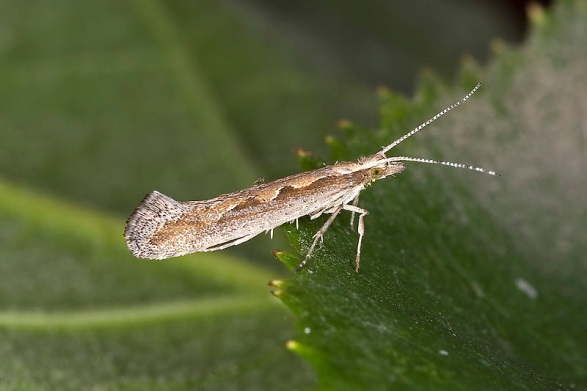
A characteristic feature of butterflies are antennae, sometimes reaching 2/3 of the wing length.
In total, 3 or even 4 generations of the pest can form during the warm season. Due to their abundance, they can survive, despite the fact that they themselves are food for several dozen species of animals - from birds and small mammals to insects and ticks.

Caterpillars, several days old, feed on the underside of the leaf.
According to agronomists in the CIS, caterpillars are damaged to varying degrees:
- early cabbage varieties - from 15 to 17% of crops;
- medium - from 17 to 18%;
- late - from 32 to 47%;
- rapeseed - from 19 to 60%.
Even for people unfamiliar with agriculture, it is clear that the cabbage moth larvae cause significant damage to all cruciferous crops grown today, so the fight against it is an important task.
Signs of a cabbage moth
Having hatched from the egg, the caterpillars of the cabbage moth penetrate into the flesh of the leaves, where they begin to gnaw through the winding passages (so-called "mines") several millimeters long. At this stage, it is almost impossible to detect the pest.
After 2 days, they have their first molt, and after a few more hours they begin to actively feed on the pulp, leaving only a thin skin from them. On the 4-5th day of life, they pierce it and come out to the lower surface of the leaves. In rapeseed crops, caterpillars primarily damage the seeds at this stage.
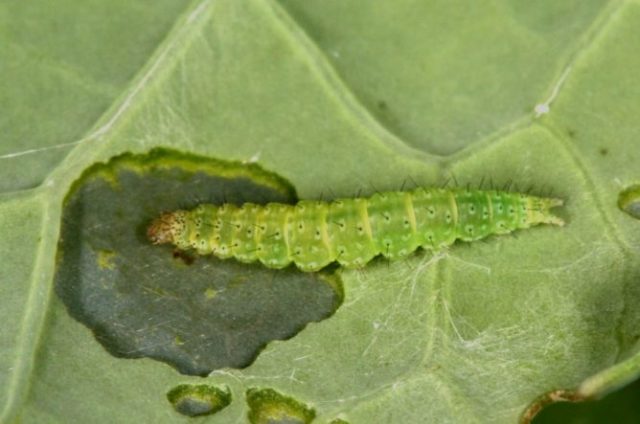
At a later date, the caterpillars practically do not hide.
The protective coloration protects them well from predators, so the population size, despite the change in behavior, practically does not suffer.
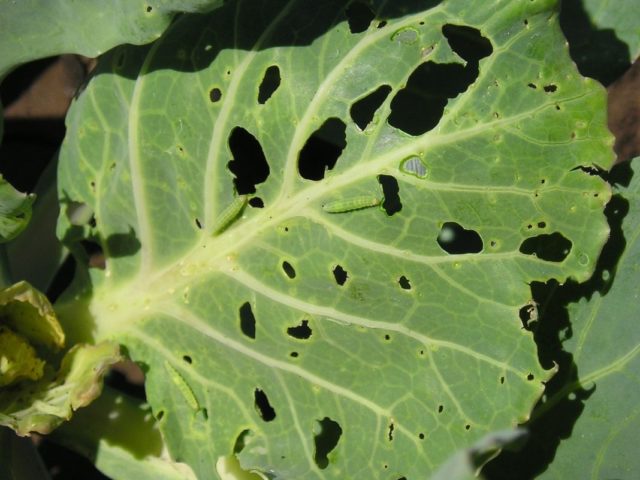
Unlike the whites, which make relatively large holes, the cabbage moth leaves behind leaves that have multiple small damages.
The vegetative part of the plant is mainly eaten at the periphery, but in some cases the heads of cabbage can also be damaged. The total life time in the larval stage is about two weeks for the pest. Then the cabbage moth pupates, and after 7-10 days a butterfly appears from the pupa, giving life to the next generation.
How to deal with cabbage moth
Despite the prevalence of the pest and its exceptional fertility, there are many effective methods of controlling it. These include both the use of chemicals and folk remedies.
Measures to combat cabbage moth folk remedies
Traditional methods of dealing with cabbage moths are very diverse and inventive. The most popular ones are discussed below.
Attracting natural enemies
Wasps or ants fight insects most effectively. It is relatively easy to attract these arthropods - it is enough to place sweets on the site or pour a sweetened solution on the soil.
Using odors
Most insects smell great, not all of them are pleasant for arthropods. This feature is actively used. By planting crops near the cabbage that have a pungent or too strong odor, it is highly likely to drive the cabbage moth butterflies away from the site.
These plants include garlic or onions, potatoes, tomatoes, coriander, lovage, calendula.

The recommended distance from the cabbage beds to the planting site of repelling crops is 1 m
If you do not want to engage in planting plants, you can use various infusions. An effective remedy is a decoction of nightshade tops. To prepare it, you will need the following ingredients:
- 3 kg of tomato or potato tops;
- several heads of onions or garlic (you can use onion peels);
- 1 red hot pepper;
- 50 g of soap.
The ingredients are mixed in a container with 10 liters of water and infused for 24 hours. Then this mixture is sprayed with cabbage plantings.
Another effective remedy is acetic acid. It is diluted in an amount of 30 ml in 10 liters of water and is also used for spraying.
Soda application
Baking soda is mixed with flour in equal proportions and the resulting powder is sprinkled with cabbage heads. This method is considered one of the safest.
Using traps
The emergence of cabbage moth butterflies occurs at night. In this case, insects willingly fly to light sources. Traps are downward-pointing flashlights. A saucer with vegetable oil is placed at a distance of 10-15 cm from the light source. The entire structure is placed on the ground or suspended from a tree.
Butterflies of the cabbage moth, attracted by the light, fall into the oil and can no longer get out of it. One such trap can kill up to hundreds of insects per night.
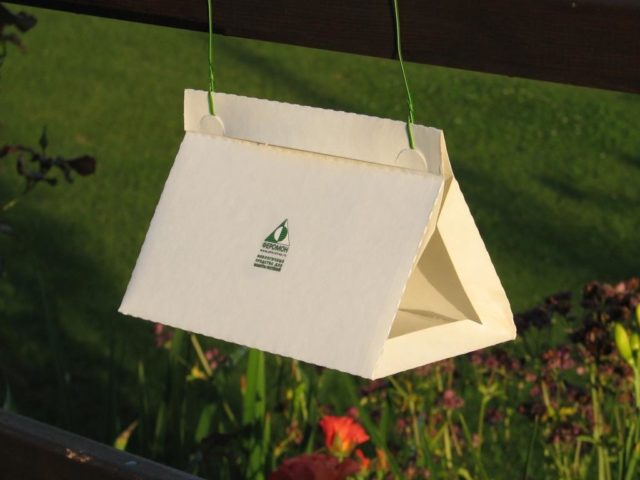
Purchased pheromone butterfly traps can kill up to a dozen insects a day
Biologicals against cabbage moth
Biological or bacterial insecticides are highly effective, but their effect has a certain time delay (from 4 to 12 hours). However, in comparison with chemicals, they are less harmful, since they usually act against some specific types of pests.
For cabbage moth, the use of Lepodocid, Bitoxbacillin, Dipel, Dendrobacillin will be effective.
The listed preparations are effective in the colonization of plants with a pest from 10 to 25%.
Chemical insecticides against cabbage moth
Chemicals are another option for pest control. Usually, the larvae and adults of the cabbage moth die within 1-2 hours after their application. Most drugs are based on pyrethroids, peritrins, or cypermethins. It is recommended to use such means if the degree of damage by cabbage moth exceeds 10-20%.
The most popular drugs are Butizan, Triflutex, Decis.
With a significant number of insects, stronger insecticides should be used: Iskra, Sherpa, Inta-vir.
The use of chemical or biological preparations is undoubtedly the most effective way to combat cabbage moth, but one should not forget about their harm to humans and beneficial insects.
Prevention of the appearance of cabbage moth
In any case, the fight against cabbage moth is a rather painstaking and costly occupation (both in time and in terms of money). Therefore, the best way to counter the pest is regular prophylaxis. Below is a list of measures that will help to effectively resist the cabbage moth and prevent it from settling on most of the crops:
- Regular cleaning of the soil from plant residues (fallen leaves, branches, tops, weeds, etc.)
- Covering the beds with agrofibre, fine mesh, spunbond and other similar materials to prevent butterflies from laying eggs.
- Planting around the perimeter of the planting and between the beds of "frightening" crops: coriander, celery, parsley, lemon balm, etc. The aroma of these plants will reliably protect crops not only from cabbage moths, but also from many other uninvited guests.
- Installation of birdhouses and nest boxes on the site to attract birds.
- Regular inspection of Cruciferous leaves and search for laid eggs on them, followed by destruction.
- Treatment of seeds before sowing with disinfectants. This measure is especially effective in combating cabbage moths on rapeseed.
- Mulching cabbage beds with odorous agents (for example, needles).
- Combining top dressing with preventive procedures (for example, using a natural insecticide in the form of wood ash).
All of these methods are quite simple and much less laborious than direct pest control using any means.
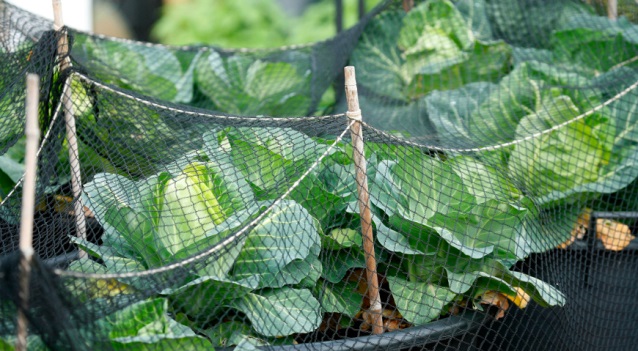
Covering the beds with a net is one of the effective methods of protection
Conclusion
Cabbage moth is one of the main pests of cruciferous vegetables. This small parasite is capable of giving up to four generations per year. Small insect larvae can damage up to 50% of planted crops, significantly reducing the yield and presentation of vegetables. The fight against them is quite difficult and time-consuming, therefore, various preventive measures are recommended.








